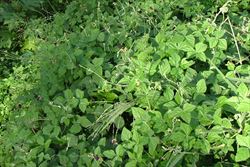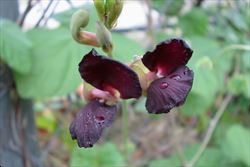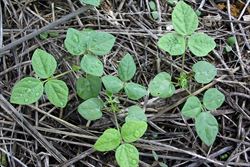Click on images to enlarge

infestation (Photo: Sheldon Navie)

creeping habit (Photo: Sheldon Navie)

habit growing on a fence (Photo: Sheldon Navie)

close-up of stem and leaf with slightly-lobed leaflets (Photo: Sheldon Navie)

flowers (Photo: Sheldon Navie)

close-up of flowers (Photo: Sheldon Navie)

immature fruit (Photo: Sheldon Navie)

mature fruit (Photo: Sheldon Navie)

close-up of seeds (Photo: Steve Hurst at USDA PLANTS Database)

seedlings (Photo: Sheldon Navie)
Scientific Name
Macroptilium atropurpureum (DC.) Urban
Synonyms
Phaseolus atropurpureus DC.
Family
Fabaceae (Queensland, the ACT, Victoria, Tasmania, and the Northern Territory)Fabaceae: sub-family Faboideae (New South Wales)Leguminosae (South Australia)Papilionaceae (Western Australia)
Common Names
atro, atro siratro, cowpea, macroptilium, phasey bean, purple bean, purple bush-bean, purple bushbean, siratro
Origin
Native to southern USA (i.e. Texas), Mexico, Central America (i.e. Belize, El Salvador, Guatemala, Honduras, Nicaragua and Panama), the Caribbean and northern South America (i.e. French Guiana, Brazil, Colombia, Ecuador and Peru).
Cultivation
Widely cultivated in tropical regions, in central and south-eastern Queensland and in north-eastern New South Wales as a pasture plant. The cultivar 'Siratro' is by far the most well known, but the more recently developed 'Aztec' cultivar is also common in cultivation.
Naturalised Distribution
Widely naturalised in the northern parts of Australia, particularly in wetter coastal districts. It is common and widespread in eastern and northern Queensland, in north-eastern New South Wales, in the northern parts of the Northern Territory and in the Kimberley region in northern Western Australia. Occasionally naturalised in the inland parts of Queensland and the Northern Territory, along the central coast of New South Wales and near Perth in south-western Western Australia. Also naturalised on Christmas Island, Lord Howe Island and the Cocos Islands.
Habitat
A weed of disturbed sites, waste areas, roadsides, fences, gardens, coastal environs, urban bushland, watercourses (i.e. riparian areas) and plantation crops (e.g. sugar cane). It is primarily found in high rainfall tropical and sub-tropical coastal areas but is occasionally also present in warmer temperate regions and in wetter habitats in semi-arid and arid inland areas.
Habit
A long-lived (i.e. perennial) herbaceous plant with creeping (i.e. decumbent) or climbing stems usually growing 2-3 m long. It stems may occasionally reach up to 5 m in height when climbing up over taller vegetation.
Distinguishing Features
- a robust creeping herbaceous plant or climbing vine with hairy stems.
- its leaves are compound with three slightly-lobed leaflets.
- its pea-shaped flowers are dark reddish-purple or blackish-purple in colour.
- its fruit are slender pods up to 10 cm long.
Stems and Leaves
The stems are ribbed lengthwise and hairy (i.e. pubescent). Older stems at the base of older plants are fibrous and about 5 mm thick, while younger stems are slender (1-2 mm thick) and green in colour.
The compound leaves (6.5-12 cm long) each have three leaflets (i.e. they are trifoliate). These leaves are alternately arranged along the stems and borne on stalks (i.e. petioles) 2-5 cm long. Individual leaflets (2-7 cm long and 1-5 cm wide) are almost oval (i.e. elliptic), egg-shaped in outline (i.e. ovate) or somewhat diamond-shaped (i.e. rhombic), but the two side (i.e. lateral) leaflets on each leaf are usually slightly lobed. They otherwise have entire margins and their undersides are usually densely hairy (i.e. pubescent). There is also a pair of small leafy appendages (i.e. stipules) 3-5 mm long at the base of each leaf stalk (i.e. petiole).
Flowers and Fruit
The pea-shaped flowers are dark reddish-purple or reddish-black in colour and several (6-12) are crowded toward the tips of long flower stalks (i.e. peduncles) 10-30 cm long. Each flower (1.5-2.6 cm long) is borne on a very short stalk (i.e. pedicel) 1-2 mm long. They have a small upper petal (i.e. standard), two large side petals (i.e. wings) and two pinkish lower petals that are fused together (i.e. into a keel) and strongly twisted or coiled. They also have five small green sepals (5-10 mm long) that are fused together at the base in to a short tube (i.e. calyx tube), ten stamens, and an elongated ovary topped with a style and stigma. Flowering occurs throughout the year.
The long and narrow (i.e. linear) pods are cylindrical and turn from green to brown in colour as they mature. These pods (5-10 cm long and 3-5 mm wide) are shortly hairy (i.e. pubescent) and split open when mature to release about 12 seeds. The seeds (about 4 mm long and 2 mm wide) are somewhat egg-shaped (i.e. ovoid) or slightly kidney-shaped (i.e. reniform) and speckled light brown and black.
Reproduction and Dispersal
This species reproduces by seed. Seeds are forcibly ejected from the pod when mature, and can be thrown for several metres. They can also be dispersed greater distances through water movement and following ingestion by cattle.
Environmental Impact
Siratro (Macroptilium atropurpureum) is regarded as an environmental weed in Queensland, the Northern Territory, northern Western Australia and northern New South Wales. It is listed as a priority environmental weed in at least one Natural Resource Management region and is actively managed by community groups in the Northern Territory. This species can form dense infestations along forest margins, and will grow over native shrubs, grasses and young trees, effectively smothering them.
Siratro (Macroptilium atropurpureum) is currently of most concern in south-eastern Queensland, where it is ranked among the top 50 environmental weed species and appears on numerous local environmental weed lists (e.g. in Gold Coast City, Ipswich City and Redlands Shire). It has also invaded riparian vegetation and coastal sand dune vegetation in this region and is a problem in revegetation sites, where it smothers young trees and shrubs before they become established. However, siratro (Macroptilium atropurpureum) is also of concern in many other parts of Queensland (e.g. in the Burdekin rangelands, in the wet tropics bioregion and a troublesome environmental weed encountered in rehabilitation projects in the Townsville region).
In Western Australia it grows along creek lines and drains in the Kimberley region, especially around Lake Kununurra, while in New South Wales it is mainly naturalised in pastures and along roadsides north from the Sydney region.
Legislation
Not declared or considered noxious by any state government authorities.
Management
For information on the management of this species see the following resources:
- the Biosecurity Queensland Fact Sheet on this species, which is available online at http://www.dpi.qld.gov.au.
Similar Species
Siratro (Macroptilium atropurpureum) is similar to phasey bean (Macroptilium lathyroides). However these species can be distinguished by the following differences:
- siratro (Macroptilium atropurpureum) is a creeping or climbing plant with dark purple-red flowers.
- phasey bean (Macroptilium lathyroides) is an upright plant (usually less than 1 m tall) with bright red flowers.
Siratro (Macroptilium atropurpureum) is also very similar to burgundy bean (Macroptilium bracteatum), which is also cultivated in Australia and sparingly naturalised in tropical Queensland. However, burgundy bean (Macroptilium bracteatum) differs by having a cluster of small leafy bracts near the base of each of its flower stalks (i.e. peduncles).

